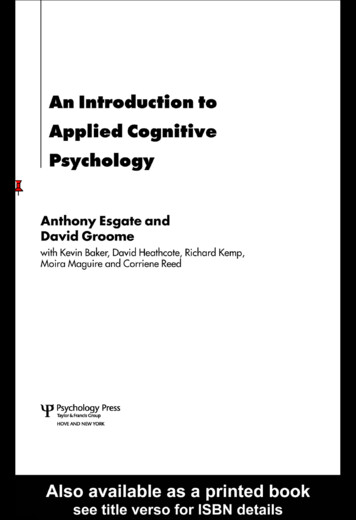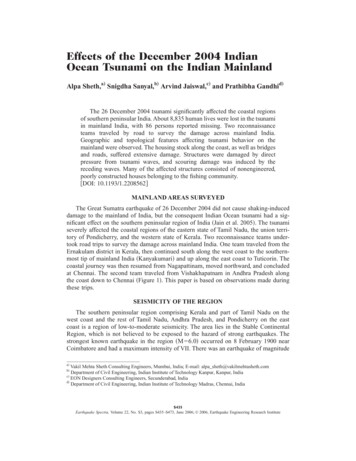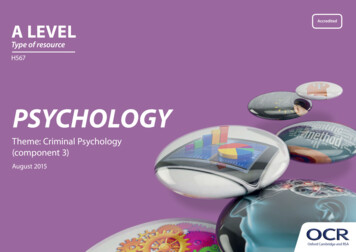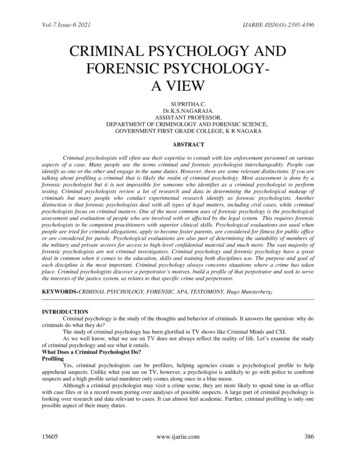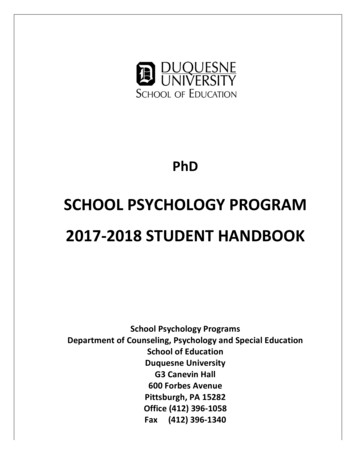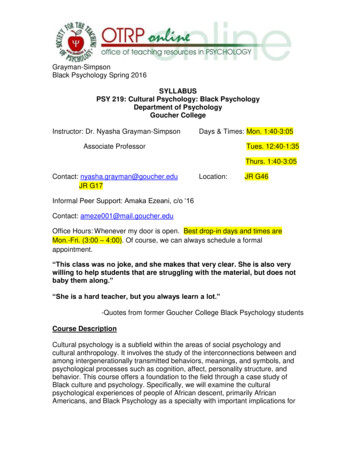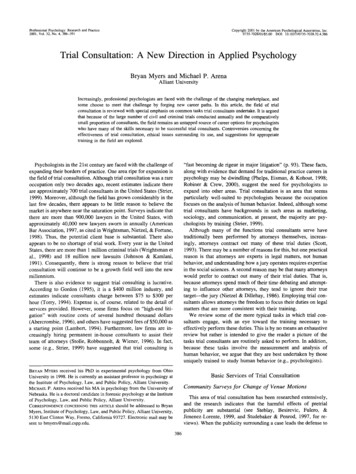
Transcription
M.SC- APPLIED PSYCHOLOGYCurriculum and Syllabus
APSY : 411: SCHOOLS AND SYSTEMS OF PSYCHOLOGYUnit: IScientific basis of Psychology – Major areas of Psychological research – goals of Psychology.Unit: IIStructuralism – basic concepts – view on human nature – merits – limitations.Unit: IIIFunctionalism – key concepts – view on human nature - applications – merits – limitations.Unit: IVBehaviourism – basic idea – principles of learning – applications – merits – limitations.Unit: VGestalt Psychology – key concepts – human perception and laws of perception – applications –merits – limitations.Unit: VIPsychoanalysis – basic concepts – conceptualization of human personality – applications –merits – limitations.Unit: VIINeoFreudian approaches to Psychology – contributions of Karen Horney Stack Sullivan,Erich Fromm – applications.Unit: VIIIHumanistic perspective – Major contributions – Maslow’s Hierarchy of Needs – Carl Rogersview on Human personality – Applications.Unit: IXPsychology today – fire views of behaviour – Biopsychology – cognitive psychology –applications – merits – limitations.Unit: XApplications of Psychology – major areas and fields of Psychology – multiculturalperspectives.Text Books:Introduction to Psychology, Morgan Et. Al, Tata Megarow Hill,2000Introduction to Psychology, Dennins Coon, Thompson Leaning, Asia Ltd. 2001.Reference Books:Understanding Psychology, Feldman, Tata Megraow Hill 2000Psychology Applied to Modern Life, Weiben and Lloyd, Thompson Leaning, Asia Ltd. 2004.********
APSY: 412: ADVANCED GENERAL PSYCHOLOGY – ILearning Objectives: To enable the students to understand The Meaning, history and biological basis of Psychology The nature of Consciousness, sensation, perception and their principles The nature and theories of learning, memory and forgetting The Basic Concepts and Theories of motivation, emotions and stress and theories ofcognitionUnit – I – Introduction : Psychology a Science and a perspectiveDefinition – Brief history – Modern Psychology – Its Grand Issues and Key Perspectives –Teends for the Millennium – Psychology and the Scientific Method – Research methods inPsychology.Unit – II – Biological Bases of BehaviorNeurons : Building Blocks of the Nervous System – The Nervous System: It’s Basic Structureand Functions – The Brain: Where Consciousness Is – The Brain and Human Behavior: WhereBiology and Consciousness Meet – Heredity and Behavior: Genetics and EvolutionaryPsychology.Unit – III – SensationSensation: The Raw Materials of Understanding – Vision – Hearing – Touch and other SkinSenses – Small and Taste: The Chemical Senses – Kinesthesia – Vestibular SenseUnit – IV – PerceptionPerception – Putting all together – Plasticity of perception: To what Extent is it Innate orLearned? Nature – Definition – Extrasensory perception: Perception without Sensation?Unit – V – State of ConsciousnessBiological Rhythms: Tides of life and consciousness experience – Waking State ofConsciousness – Sleep: the pause that refreshers – Hypnosis: Altered State of Consciousness –Consciousness – Altering Drugs: What they are and what they do.Unit – VI – Learning – How we are changed by experienceDefinition – Classical Conditioning: Learning That some Stimuli Signal others – OperantConditioning: Learning Based on Consequences – Observational learning: Learning from theBehavior and Outcomes of others.Unit – VII – Memory and Forgetting – of things remembered and forgotten.Human memory – Two influential views – Kinds of information stored in Memory – STM –LTM – Memory in everyday life – Memory distortion – Improving memory forgetting –Contrasting Views – Nature – Causes.Unit – VIII – CognitionThinking – Forming Concepts and Reasoning to Conclusions – Making Decisions: Chosingamong Alternatives – Problem Solving: Finding Paths to Desired Goals – Language – Nature –Development – Language: The Communication of Information.
Unit – IX – Motivation and EmotionMotivation: The Activation and Persistence of Behavior – Basic concepts – Theories ofMotivation – Aggressive Motivation – Sexual Motivation – Motivation to Know and to beEffective – Biological Motivation.Unit – X – Emotion: Their Nature, Expression and Impact – Biological Basis of Emotion –External Expression of Emotion – Theories of Emotion – Emotions and Cognitions – BodyLanguage.Text BookBaron.A. Robert (2001). Psychology. New Delhi, Prentice Hall of India.Suggested Readings:Hilgard, E.R. (1999). Introduction to Psychology (6th Edition), New Delhi; Oxford and IBHPublishing Co, Pvt Ltd.Mangal S.K (1999). General Psychology, New Delhi, Surjeeth Publications.Morgan, C.T. King, R.A., Weisy, J.R. Scooper, J. (1993). Introduction to Psychology, NewDelhi, Tata Mc-Graw Hill Publishing Company.*********
APSY: 413: ADVANCED SOCIAL PSYCHOLOGY – IThe Field of Social Psychology:Unit – 1: Definition – Current and Future Trends – Methods of Social Psychology.Social PerceptionUnit – 2: Nonverbal Communication – Attribution – Impression Formation and ImpressionManagement.Social CognitionUnit – 3: Schemas: Types of schemas – Impact of schemas on social cognition. Heuristics :Types.Unit – 4: Potential Sources of Error in Social Cognition: Rational versus intuitive processing –Dealing with inconsistent information – The Planning Fallacy – The potential costs of thinkingtoo much – Counterfactual thinking – Magical thinking – Thought suppression.AttitudesUnit – 5: Meaning – formation of Attitudes: Social Learning – Social Comparison – Geneticfactors. Influence of Attitude on Behaviour.Unit – 6: Changing attitudes: Persuasion: Meaning – The Early Approach – Cognitiveapproach to persuasion – other facxtors affecting persuasion. Factors in Resistance to attitudechange. Cognitive Dissonance.Aspects of Social identityUnit – 7: The Self: Self – Concept – Self – Esteem – Other Aspects of Self Functioning :Focusing – Monitoring – Efficacy.Unit – 8: Gender: Gender Identity and Gender stereotypes – Gender Role Behaviour andReactions to Gender role Behaviour – Discrimination in the work place – Differences betweenmen and women : Biology – Gender Role.Prejudice and DiscriminationUnit – 9: Prejudice and discrimination: Nature and effects. Origins of Prejudice: Directintergroup Conflict – Early Experience – Social categorization. Cognitive sources of prejudice:Stereotypes – Illusory correlations – Outgroup homogeneity.
Unit – 10: Techniques for counteringthe effects of prejudice: learning not to hate – Directintergroup contact – Recategorization – Cognitive interventions. Prejudice based on Gender:Nature and effects – Gender stereotypes – discrimination against females – Sexual harassment.Books:1. Baron, R.A & Byrne, D . Social Psychology. Delhi: Pearson Education Asia, 2000.2. Myers, D.G. Social Psychology. New Delhi: Tata – Mc. Graw Hill, 2006.3. Worcel, S.,Cooper,J.,Goethals,G.R., & Olson, J.M. Social Psychology. CA:Wadsworth,2000.********
APSY: 414: DEVELOPMENTAL PSYCHOLOGY – IUnit – IGROWTH AND DECLINE – PRINCIPLES AND FACTS OF DEVELOPMENTIntroduction; The scope of developmental psychology; Scope of life span development;Principles and facts of development.Unit – IITHE CHARACTERISTICS OF PRE – NATAL PERIODIntroduction; Characteristics of prenatal period; Conception; Importance of conception;Hereditary endowment; Ordinal position; Attitude of significant people; Conditions influencingattitude; Hazards during prenatal period; Physical hazards; Psychological hazards.Unit – IIIINFANCY – CHARACTERISTICS OF MAJOR ADJUSTMENTS AND HAZARDSIntroduction; Characteristics of infancy period; Conditions influencing adjustment to postnatallife; Postnatal care; Emotions of the new born; Hazards in infancy.Unit – IVBABYHOOD – ICharacteristics of babyhood; Developmental tasks; Physiological functions; SpeechdevelopmentUnit – VBABYHOOD – IIBeginning in the interest in play; Beginning of morality; Role of discipline in babyhood; Sexrole typing; Personality development in babyhood; Hazards in babyhoodUnit – VIBABY HOOD – IIIThe process of socialization in babyhood; The emotional patterns in babyhood; The familyrelationship pattern in babyhood
Unit – VIIEARLY CHILDHOODCharacteristics of early childhood; Developmental tasks; Physical development; Improvementin speech and comprehension; Improvement in speech skills; Content of speech; Emotions;Socialization; Companions Types of leadership; Play and moral developmentUnit – VIIIDISCIPLINE IN EARLY CHILDHOODCommon interests in early childhood; Family relationships in early childhood; Hazards in earlychildhoodUnit – IXLATE CHILDHOOD – ICharacteristics of late childhood; Physical development in late childhood; Skills of latechildhood; Speech improvement in late childhoodUnit – XLATE CHILDHOOD – IICommon emotional pattern of late childhood; Characteristics of childhood’s gangs; Playinterests in late childhood; Hazards in late childhood.*********
APSY: 415: PSYCHOLOGICAL STATISTICS – IUnit – I : The Frequency distribution1. Measurement2. Drawing up a Frequency distribution3. The graphic representation of the frequency distributionUnit – II : Measures of central tendency1. Calculation of measures of central tendencies – Mean, Median and Mode2. Significance of measures of central tendencies3. When to use the various measures of central tendencies.Unit – III : Measures of variability1. Calculation of measures of variability2. Significance of measures of variability3. When to use the various measures of variabilityUnit – IV : Cumulative distributions; Graphic methods and percentiles1. The cumulative frequency graphs2. Percentiles and percentile ranks3. The cumulative percentile curve or Ogive4. Graphic methodsUnit – V : The normal distribution1. The meaning and importance of the normal distribution2. Properties of the normal probability distribution3. Applications of the normal probability curve4. probability and basic terminologyUnit – VI : Correlation1. The meaning of correlation2. The coefficient of correlation3. The calculation of the coefficient of correlation by the product moment method4. Correlation coefficient for ranked data.Unit – VII : Alternative correlational Techniques1. Biserial correlation2. Point – Biserial correlation3. The Phi – Coefficient4. Tetra choric Correlation5. Kendall’s Tau’s coefficientUnit – VIII : Regression and prediction1. The regression equations2. The accuracy of predictions from regression equations3. Factors affecting the interpretation of ‘r’4. The interpretation of the coefficient of correlation
Unit – IX : Categorical data and Chi-Square1. Statistical importance of the Chi-square distribution2. The Chi-Square test – one – way classification3. Chi-Square as a test of the independence of two variables4. Chi-Square for Larger contingency tables5. Measures of associationUnit – X : The significance of the difference between Means and other statistics1. The significance of the difference between means2. The significance of the difference of the SD’s3. The significance of the difference between percentages and correlation coefficients.********
APSY: 416: PSYCHOPATHOLOGY – IObjectives:1. To define and explain abnormal behaviour with a historical note based on multi – perspectiveapproach.2. To deal with vital issues pertaining to assessment and diagnosis of various conditions ofabnormality.3. To describe and elucidate abnormal conditions such as anxiety disorders, dissociative andsomatoform disorders.Unit – I : INTRODUCTION¾ Definition of Abnormal Behaviour¾ Explanation of Abnormal Behaviour¾ Conceptions of Abnormal Behaviour – A short History with special reference to classificationof psychological disorders¾ A multi – perspective approach – psychological and biological perspectivesUnit – II : PSYCHODYNAMIC PERSPECTIVE¾ The psychodynamic perspective – basic concepts of Freudian theory; the descendants of Freud;evaluating the psychodynamic perspective.Unit – III : HUMANISTIC – EXISTENTIAL PERSPECTIVE The Humanistic – Existential perspective – the background and underlying assumptions ofhumanistic and existential psychology; comparing humanism and existentialism evaluatingthe humanistic and existential perspective.Unit – IV :BEHAVIOURAL PERSPECTIVE Behavioural perspective – the background and assumptions of behaviourism; the mechanismsof learning; Neobehaviourism (cognitive behaviourism); abnormal behaviour as a product oflearning; evaluating behaviourism.Unit – V : COGNITIVE PERSPECTIVE The cognitive perspective – the background of the cognitive perspective; cognitive appraisal,self-reinforcement; information processing; evaluating the cognitive perspective.Unit – VI : SOCIO – CULTURAL PERSPECTIVE The socio – cultural perspective – psychopathology as the product of social pathology;psychopathology as a social institution; evaluating the social – cultural perspective.Unit – VII : BIOLOGICAL PERSPECTIVE Behavioural GeneticsThe central nervous systemThe peripheral nervous system – somatic and autonomicThe endocrine systemEvaluating the biological perspective
Unit – VIII :ASSESSMENT AND DIAGNOSIS Assessment: The issues – need for assessment; psychiatric diagnosis and classification ofabnormal behaviour (DSM – IV TR/CD -10); problems in assessment. Methods of Assessment – the interview; psychological tests; laboratory tests; observation innatural settings. Theoretical perspectives on assessment – the psychodynamic approach; the behaviouralapproach; the cognitive approach; the humanistic – existential approach; the biologicalapproach.Unit – IX : ANXIETY DISORDERS Panic disorderGeneralized anxiety disorderPhobic disorderObsessive – compulsive disorderPost – traumatic stress disorderTheoretical perspectives on the anxiety disordersUnit – X : DISSOCIATIVE AND SOMATOFORM DISORDERS Dissociative disorders – psychogenic amnesia; psychogenic fugue; multiple personality;depersonalization disorder. Somatoform disorders – hypochondriasis; somatization; conversion disorder. Perspectives on the dissociative and somatoform disorders.References:1.2.3.Bootzin, R.R., Acocella, J.R. and Alloy, L.B. (1993) Abnormal Psychology – CurrentPerspectives, 6th edition, New York: Mc-Grans – Hill, inc.Sarason, I.G. and Sarason, B.R. (1998) Abnormal Psychology: The problem of MaladaptiveBehaviour, New Delhi: Prentice – Hall of India.Carlson, R.C., Butcher, J.N. and Mineka, S. (1998) Abnormal Psychology and Modern Life,New York: Addison Wesley Longman.*********
APSY: 421: Experimental PsychologyMeasurement / Assessment ofLocalization of soundPlotting the visual Field and Colour ZonesVisual AcuityVisual Perception, IllusionConstancy of PerceptionDepth PerceptionThresholdsKinesthetic SensitivityReaction TimeTypes of LearningMemoryMotivesJudging EmotionsIntelligenceProblem SolvingCreativityPersonalityAttitudesSocial BehaviourFamily EnvironmentLoneliness****************
APSY: 422: Advance General Psychology – IILearning Objectives: To enable the students to understand The meaning and Theories of Cognitions, Intelligence and Personality The nature and theories of Health Psychology, Concepts of Wellness and illness and itsimpact on behavior pattern The meaning of Stress and Coping mechanisms The Dynamics of Social Cognition and Social Behavior The Basic concepts of life span development and its implications.Unit – I - IntelligenceIntelligence – Definition – Nature – Meaning – Contrasting Views of its Nature – Nature versusNurture – The Role of Heredity and The Role of Environment – Individual and Group Differences.Unit – II - Measuring Intellignece and CreativityMeasurement of Intelligence – Emotional Intelligence – Theories of Intelligence – Assessment ofIntelligence – Creativity – Techniques of Creativity.Unit – III – PersonalityMeaning and Definition – Theories – The Psychoanalytic Approach: Messages from theUnconscious – Humanistic Approach: Emphasis on Growth – Trait Theories: Seeking the KeyDimensions of Personality – Learning Approaches to Personality – Modern Research onPersonality.Unit – IV – Measuring PersonalityMeasuring Personality-Self Report Tests of Personality: Questionnaires and Inventories – ProjectiveMeasures of Personality – other measures: Behavioral Observations – Interviews – BiologicalMeasuresUnit – V - Health PsychologyHealth Psychology: An Overview – Understanding and Communicating our Health Needs –Beavioural and Psychological Correlates of Illness: The effects of thoughts and actions on health –promoting wellness: Developing a healthier lifestyle.Unit – VI – Stress, and CopingStress: Its causes, effects, and control – Basic nature – some Major causes – some Major effects.Unit – VII – Social thought and Social BehaviorSocial thought: Thinking about other people – Attribution – Understanding the cause of other’sBehavior – Social cognition: How we process Social informationUnit – VIII – Social BehaviorSocial Behavior: Interacting with others – Prejudice: Distorted views of the Social world – SocialInfluence: Changing other’s Behavior – Attraction and Love – Leadership one important groupprocess.
Unit – IX - Human Development I – The Childhood YearsPhysical Growth and Development – Perceptual Development – Cognitive Development: Changesin our Ability to understand the world around Us.-Moral Development: Reasoning about “Right”and “Wrong” – Social and emotional Development: Forming Relationships with others – Fromgender identity to Sex – Category Constancy: How Children come understand that they are Femaleor Male.Unit – X – Human Development II – Adolescence, Adulthood, ad AgingAdolescence: Between Child and Adult – Development during our Adult years – Aging – Death –Bereavement.Text BookBaron.A.Robert (2001). Psychology. New Delhi, Prentice Hall of India.Suggested Readings:Hilgard, E.R. (1999). Introduction to Psychology (6th Edition), New Delhi; Oxford and IBHPublishing Co, Pvt Ltd.Mangal S.K. (1999). General psychology, New Delhi, Surjeeth Publications.Morgan C.T. King, R.A., Weisy, J.R. Scooper, J. (1993). Introduction to Psychology, New Delhi,Tata Mc-Graw Hill Publishing Company.*********
APSY:423: Advanced Social Psychology – IIInterpersonal AttractionUnit – IRecognizing and Evaluating Strangers: repeated Unplanned Contacts – Affective State – the needto affiliate and the effect of Observable Characteristics – Similarity and Reciprocal PositiveEvaluations.Close RelationshipsUnit – IIThe First Relationships – Relationships beyond the Family – Effects of Attachment style on AdultRelationships – Loneliness – Romantic relationships, Love and Physical intimacy – Marriage.Social InfluenceUnit – IIIConformity : Factors – Bases of Conformity – Need for individuality and personal control –Minority influence. Compliance : Underlying Principles – ingratiation – Foot in the door andlowball – The door in the face – Playing hard to get – Complaining and putting others in a goodmood. Individual differences in the use of social influence. Obedience: Destructive obedience:Some basic findings – Its Social Psychological Basic – Resisting its effects.Prosocial BehaviourUnit – IVResponding to an Emergency: Providing help: Essential Steps – Situational factors.Unit – VHelping as a function of Bystander’s Emotional state – Dispositional differences in prosocialResponding – Volunteering – explaining prosocial behaviour: Empathy – Negative state Relief –Empathic joy – Genetic determinism.AggressionUnit – VITheoretical Perspectives on Aggression: Instinct Theories and the role of Biological factors – DriveTheories – Modern Theories of Aggression: Learning – Cognitions – Mood and Arousal.Unit – VIIDeterminants of human Aggression: Social Determinants – Personal causes – SituationalDeterminants. Child Abuse and workplace Violence. Prevention and Control of Aggression:Punishment – Catharsis – Other techniques.
Groups and individualsUnit – VIIIGroups: Nature and Function – impact of Groups on Individual performance: Social facilitation –Social Loafing. Coordination in Groups: Cooperation – Conflict.Unit – IXPerceived fairness in Groups: Judgement of Fairness –Reactions to Perceived Unfairness. Decisionmaking by Groups: The Decision – Making Process – the Nature of Group Decisions – Potentialdangers of Group Decision Making.Unit – XApplying Social Psychology: Interpersonal Aspects of the legal System – Health related Behaviour- Work.Books:1.2.3.4.Baron, R.A & Byrne,D.Social Psychology. Delhi: Pearson Education Asia, 2000.Myers,D.G.Social Psychology. New Delhi: Tata – Mc Graw Hill, Social Psychology. CA:Wadsworth,2000.Vangelisti,A.L & Perlman,D(Ed). The Cambridge Handhook of Personal Relationships. NY:Camdridge University Press, 2006.5. Sam, D L & Berry, J.W. (Ed.). Acculturation Psychology. NY: Cambridge UniversityPress,2006.*********
APSY:424: Developmental Psychology – IIUnit – IPUBERTY – IIntroduction; Criteria of Puberty’ Characteristics of Puberty; Causes of PubertyUnit – IIPUBERTY – IIGrowth spurt; Deviations; Psychological effectsUnit – IIIADOLESCENCE – IIntroduction; Characteristics of Adolescence; Developmental tasks; Physical changes; Emotionalchanges during AdolescenceUnit – IVADOLESCENCE – IISex Behaviour and Morality; Sex role; Family relationships; Personality changesUnit – VADULTHOOD – IIntroduction; Characteristics of early adulthood; Developmental tasks; Interests in early adulthoodUnit – VIADULTHOOD – IIAdjustment to spouse; Family; Vocation; parenthood; SinglenessUnit – VIIMIDDLE AGE – IIntroduction; Characteristics of middle age; Developmental tasks; Physical changes and theirPsychological impact; Mental changes; Changes in InterestsUnit – VIIIMIDDLE AGE – IIPersonal adjustments; Social adjustments; vocational adjustments; Preparation for old ageUnit – IXOLD AGE – IIntroduction; Characteristics of old age; Developmental tasks; Physical changes; PsychologicalchangesUnit – XOLD AGE – IIAdjustment to self; Adjustment to retirement; Adjustment to family; Adjustment to singleness;Hazards of old age; The self – personality in old age.
APSY:425: Psychological Statistics – IIUnit – I : Non parametric and distribution – free statistical tests1.2.3.4.5.6.Mann – Whitney ‘U’ testWilcoxon’s matched – pairs signed rank testThe sign testThe median testKruskal – Wallis one – way analysis of varianceFriedman’s rank test for correlated samplesUnit – II : Simple analysis of variance1.2.3.4.The general approachThe logic of analysis of varianceCalculations in the analysis of varianceUnequal sample sizesUnit – III : Factorial analysis of variance1.2.3.4.The logic of analysis of varianceCalculations in the analysis of varianceUnequal sample sizesHigher order – factorial designsUnit – IV : Hypothesis Testing1.2.3.4.Hypothesis testingThe Null hypothesisType I and type II errorsOne and two tailed testsUnit – V : multiple comparisons among treatment – means1.2.3.4.5.Post – hoc comparisons – Duncan’s Multiple Range TestTukeys testsThe Scheffe testDunnett’s testTrend AnalysisUnit – VI : Analysis of variance and covariance1.2.3.4.One – way analysis of covarianceInterpreting an analysis of covarianceFactorial analysis of covarianceMultivariate analysis of variance
Unit – VII : Reliability of test scores1.2.3.4.The reliability of test scoresMethods of determining reliabilitySome other factors in reliabilityReliability of speed testsUnit – VIII : Validity of test scores1. Validity of test scores2. Types of validity3. Methods of determining validityUnit – IX : Methods of sampling1. Significance of sampling in psychological research2. Probabilistic sampling methods3. Non – probabilistic sampling methodsUnit – X : Item analysis1. Item selection2. Item difficulty3. Item validityREFERENCES;1. H.E. Garrett. “Statistics in psychology and Education” Vakils, Peffer and Simons Ltd, Bombay2. David C. Howell. “Statistical methods for Psychology” 3rd Edition, Duxbury press, California.3. Sidney Siegal. “Non – parametric statistics for the behavirioural sciences” McGraw Hill,Kogakusha, New Delhi.4. Guilford J.P & Fruchter.B. “Fundamental statistics in Psychology and education” New – York,McGraw Hill.Text Books:1. Shiamberg L.B., Human Development, New York, Macmillan Publishing Co., 1985.2. Gormly A.B. and Broadzinsky D.M., Lifespan Human Development, New York, HardcortBrace College Publishing Co., 1993.References Books:1. Van der Zanden J.W., Human Development, New Delhi, Mcgarow Hill, 1999.2. Halen B. The Developing Child, New York, Harper Collins, 1989.3. Leland M. Stott, The Psychology of Human Development, New Delhi, Macmillan andcompany, 1978.*********
APSY: 426: Psychopathology – IIObjectives:1. To throw light on stress related disorders, mood disorders, additive disorders, abnormality insexual behaviour, schizophrenia, paranoia (delusional disorders) and developmentaldisorders besides mental retardation and autism.2. To make students understand legal and ethical issues in abnormal psychology so that theymarch steadily towards professionalism.Unit – I - Psychological Stress and Physical Disorders Personality and body – autonomic reactions to stress; psychological events and physicalillness; a disregulation model. Stress – related physical disorders – systems approach; cancer. Theoretical perspectives on stress related physical disorders.Unit – II – Mood Disorders Characteristics of depressive and manic eqisodes – major depressive eqisode; maniceqisode. Mood disorder syndromes – major depression; bipolar disorder; dysthymia and cyclothymia;dimensions of mood disorder; comorbidity; mixed anxiety – depression. Perspectives on the mood disorders Suicide – prevalence; prediction; perspectives.Unit – III – Personality Disorders Personality disorders: Individual syndromes – paranoid, schizotypal, schizoid, avoidant,depentdent, borderline, histrionic, narcisstic, obsessive – compulsive, passive – aggressivepersonality disorders. Antisocial personality disorders – The psychiatric classification of antisocial behaviour;characteristics of the antisocial personality; antisocial behaviour in juveniles; conductdisorders. Theoretical perspectives on the personality disorders.Unit – IV - Additive Disorders The nature of substance dependence and abuse Alchololism, nicotine dependence, other psychoactive druges (depressants, stimulants,hallucinogens, marijuana and hashish). Perspectives on drug dependence – neuro chemistry; personality & social perspectives; drugrehabilitation; relapse prevention.Unit – V - Abnormality in Sexual Behaviour Forms of sexual dysfunction and theoretical perspectives on sexual dysfunction. Sexual deviations and theoretical views.Unit – VI - Schizophrenia and Paranoia (delusional disorders) The prevalence of schizophrenia The history of diagnostic category The symptoms of schizophrenia and its subtypes
The course (process) of schizophrenia The dimensions of schizophrenia – positive – negative symptoms dimension; paranoid –nonparanoid dimension Theories on schizophrenia Delusional disordersUnit – VII - Organic Brain Disorders Problems in diagnosis Organic brain disorders classified by etiology – cerebral infection; brain trauma; strokes;brain tumours; degenerative disorders; nutritional deficiency; endocrine disorders; toxicdisorders. Seizure disorders – types; precipitation;Unit: VIII – Disorders of Childhood and Adolescence General issues in childhood psychopathology – prevalence; classification and diagnosis. Disruptive behaviour disorders – attention deficit hyperactivity disorder; conduct disorder. Disorders of emotional distress – anxiety and childhood depression.Unit: IX Habit disorders – eating, elimination and sleep disorders. Specific developmental disorders – learning disabilities and communication disorders. Theoretical perspectives on disorders of childhood and adolescence.Unit – X - Mental Retardation and Autism Definition and levels of mental retardation Organic and environmental factors in mental retardation Autism – symptoms and perspectives Society, retardation and autism Prevention, education and rehabilitationUnit – XI - Legal and ethical issues in abnormal Psychology Psychological disturbance and criminal law Civil commitment Patients’ rights and ethical issues Power and the mental health professionReferences:1. Bootzin, R.R., Acocella, J.R. and Alloy, L.B. (1993) Abnormal Psychology – CurrentPerspectives, 6th edition, New York: Mc-Grans-Hill, Inc.2. Sarason, I.G. and Sarason, B.R. (1998) Abnormal psychology: The Problem of MaladaptiveBehaviour, New Delhi: Prentice-Hall of India.3. Carlson, R.C., butcher, J.N. and Mineka, S. (1998) Abnormal Psychology and Modern Life,New York: Addison Wesley Longman.*********
APSY: 531: ORGANIZATIONAL BEHAVIOURUNIT I- Introduction: The field of OB; Emergence of OB as a discipline and contributingdisciplines to OB; contributions of Hawthorne studies to OB; What areorganizations? Why study OB? OB trends – Globalization; outsourcing; callcentres; knowledge process outsourcing. Implications for OB; e-business and OB;telecommuting, changing work force; workplace values and ethics; The FIVEanchors of OB aid knowledge management.UNIT II- Individual behaviour and processes: Individual behaviour, Values, Personality,Perception, Attribution and Learning in organizations; Workplace emotions andattitudes; Job satisfaction: Applied performance practices; Impression management;organizational commitment.- Managerial assumptions about human nature and implied strategies.- Views and Models of man (Nature of Individuals).UNIT III - Motivational Process: Meaning of motivation; Primary motives; General motives,Secondary motives & Motivational process.Content theories of work motivation – Maslow’s Hierarchy of needs; Herzberg’stwo factor theory; ERG theory. Theory X and Theory Y.Process theories of Work motivation:Vroom’s expectancy theoryThe Porter-Lawler ModelContemporary Theories:McClelland’s Three need theoryGoal setting theory; Equit
Psychology Applied to Modern Life, Weiben and Lloyd, Thompson Leaning, Asia Ltd. 2004. ***** APSY: 412: ADVANCED GENERAL PSYCHOLOGY - I . Carlson, R.C., Butcher, J.N. and Mineka, S. (1998) Abnormal Psychology and Modern Life, New York: Addison Wesley Longman. ***** APSY: 421: Experimental Psychology Measurement / Assessment of Localization .
